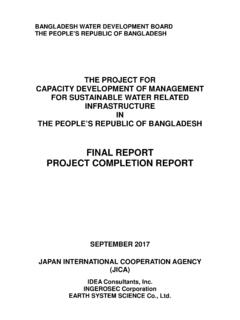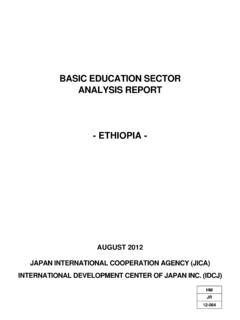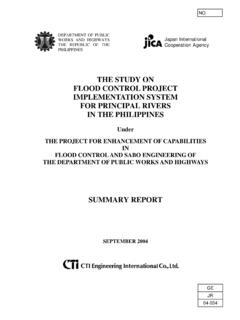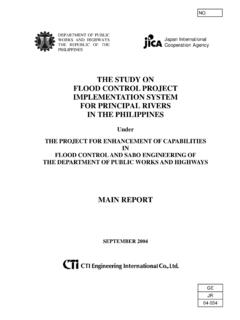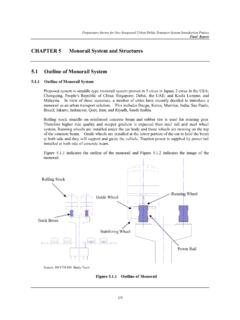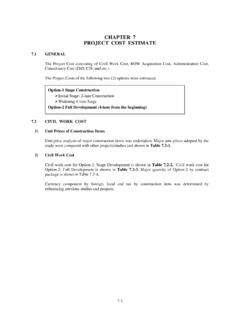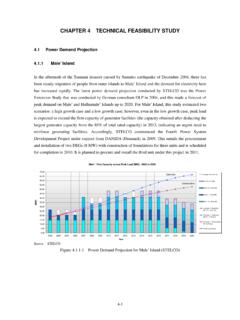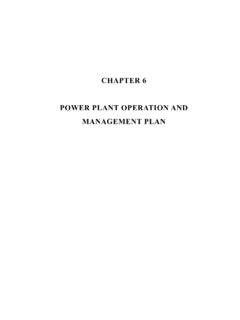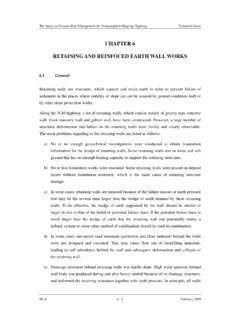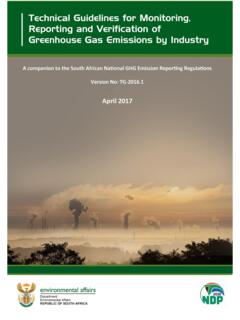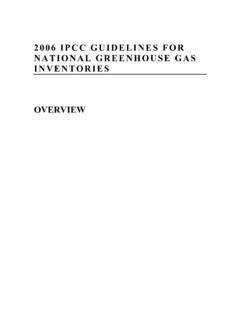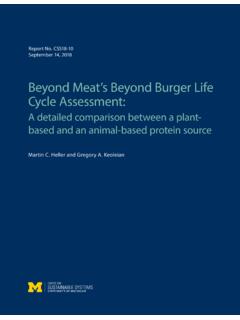Transcription of CHAPTER 14 PROPOSED ROAD OPERATION AND …
1 CHAPTER 14 PROPOSED ROAD OPERATION AND MAINTENANCE PLAN 14 - 1 CHAPTER 14 PROPOSED ROAD OPERATION AND MAINTENANCE PLAN Road Maintenance Practices Road Maintenance Works Road maintenance works are classified into three types: namely, routine, periodic and emergency. Routine maintenance is based on routine (daily) inspection of the condition of pavement, cut and fill slopes, drainage, bridges and other structures and facilities to monitor any defects and damage. The results of routine inspection will be promptly reported to the OPERATION office for follow-up maintenance works to be undertaken either continually throughout a year or at certain intervals every year. The term preventive maintenance refers to repair that addresses causes of deterioration leading to the need for costly rehabilitation work in future. Periodic maintenance is based on detailed inspection performed at certain time intervals such as seasonally or yearly depending on the type and kind of facilities.
2 It includes checking and testing the conditions of various structures and facilities. Defects and damage will be reported for repairs or remedies. Maintenance plans covering several years will be developed. Emergency maintenance basically comprises works to restore road and road related facilities to their normal operating conditions after they are damaged by road accidents or natural causes. It is impossible to foresee the frequency, but such maintenance requires immediate action. Table 14-1-1 summarizes typical activities of each type of maintenance work. Table 14-1-1 Typical Maintenance Activities Type Activity Clearing of pavement Mowing and maintenance of plants Clearing of ditches and culverts Repair of traffic signs and road markings Shoulder grading Pothole patching and crack sealing Repair of sealants and expansion joints of bridges Routine includingPreventive Repair of cut and fill slopes Regraveling Resealing/surface dressing Overlay Periodic Maintenance of traffic signs and road markings Removal of debris or obstacles from natural causes Emergency Repair of damage caused by traffic accidents For routine maintenance activities, an appropriate mix of labor and equipment is required to provide works of adequate quality in a cost-effective manner.
3 In a labor-based economy, the aim is to apply a labor/equipment mix that gives priority to labor, but supplements it with light/intermediate equipment where necessary for reasons of quality or cost. The term 14 - 2 labor-based thus indicates that flexible and optimal use is made of labor as the predominant resource in so far as cost-effectiveness and quality aspects are ensured. It is important to distinguish between an optimal use of labor and maximum use of labor. The latter could degenerate into a make work approach where cost-effectiveness and quality aspects are ignored. Equipment-based is the opposite of labor-based in that most of the work is done by labor-replacing equipment, supported by a small labor force. Present Financial Situation In the present budgetary system, the OPERATION expenditure is categorized into construction and maintenance even though the indicators are that a majority of the maintenance funds probably are spent on emergencies by provincial level and results in leaving very little for conventional maintenance activities.
4 MPWT budget comprises seven chapters, namely salaries and benefit ( CHAPTER 10), administrative expenses ( CHAPTER 11), field of economic input ( CHAPTER 30), field of social and cultural input ( CHAPTER 31), field of international input ( CHAPTER 32), investment by internal financing ( CHAPTER 50) and investment by external financing ( CHAPTER 51). It is noted that MPWT budget does not include the loan proceeds from international lending agencies but comprises the fund allocated from the national budget including the counter fund to the loan that is usually planned as CHAPTER 51 Investment By External Financing . Since the budgets are drastically changed in 1996 to 2001 depending upon the fluctuation of chapters 50 and 51, the budget of MPWT for the study purpose is prepared excluding chapters 50 and 51. Fig. 14-1-1 shows the budget of MPWT in 1996 2001. 1996 1997 1998 1999 2000 2001 Plan 4,760 4,125 3,493 4,187 16,039 19,200 Outlay 3,259 3,423 3,213 3,922 14,834 14,664 Official Exchange Rate 26402991377438143859 3924 Thousand US$ 1,235 1,144851 1,0283,844 3,737 Fig.
5 14-1-1 Budget of MPWT MPWT Budget05,00010,00015,00020,00025,0001996 19971998199920002001mil. RielPlanOutlay14 - 3 The budgets of 2000 and 2001 suddenly increase about 10 billion Riel because the road maintenance fund of 10 billion Riel equivalent to million $ is added annually in CHAPTER 30 Field of Economic Input . The budget for 2002 is planned 16,180 million Riel including the road maintenance fund of billion Riel. However, the road maintenance fund Fund for Repair and Maintaining of Road (FRMR) is transferred under the direct management of the Prime Minister and MEF according to the Sub-decree No. 39 dated May 6, 2002. The fund will use for routine and periodic maintenance and repair of the national , provincial and other roads under the management and responsibility of MPWT, Ministry of Rural Development and Ministry of Water Resource and Meteorology to drive up the use of fund effectively, according to Minister s Order No.
6 3567 of MEF dated July 24, 2002. Therefore, MPWT should request to MEF the allocation of budget for road maintenance together with planning, technical standard and financing objective from the fiscal year of 2003. In addition to the above-mentioned administrative change, MPWT through MEF officially requests to the Government of Japan in July 2002 the approval of utilization of the counterpart fund of non-project grant aid 1996 for the project Road Maintenance Catch-up Program . The project will cover the road maintenance of 1, km, amounting $ million. Present Situation of Road Maintenance The maintenance situation for existing roads has received attention in a number of recent studies under the sponsorship of the World Bank, the Asian Development Bank and Japan. It is a well-established finding that the maintenance attention given to the existing roads in Cambodia is inadequate because of very limited fund availability and institutional weakness.
7 Furthermore, the road maintenance fund is used mostly for road rehabilitation but not for road maintenance. The road inventory and its condition in Cambodia are summarized by the study Strengthening the Maintenance Planning and Management Capabilities at the MPWT funded by ADB in July 2002. Based on the final report , the inventory of road is as shown in Table 14-2-1. Table 14-2-1 Road Length under MPWT Length (Km) Type of Road Kandal national N1 Primary national Roads ,002 N2 Secondary national Roads ,754 N3-1 Provincial Roads ,700 N3-2 Urban Roads under MPWT 01,700 Total ,156 Notes: N1 Roads are the primary national roads with single digit. N2 Roads are the secondary national roads with double digit. N3-1 Roads are the provincial roads. N3-2 Roads are the urban roads under the jurisdiction of MPWT. 14 - 4 MPWT is responsible for maintenance of 12,156 km long road, and the source of fund for road maintenance is the revenue accrued from fuel taxes and vehicle registrations.
8 The following jurisdictions are set forth on NR-1 C-1 Section (Phnom Penh to Neak Loueng) under current road maintenance system in the study area: i) NR-1 C-1 Section from the beginning point to Veal Sbov, L= km is under jurisdiction of DPWT of Phnom Penh Municipality. ii) NR-1 C-1 Section from Veal Sbov to Neak Loueng, L= km is under jurisdiction of DPWT of Kandal province. iii) Emergency flood rehabilitation project under PMU-I maintains NR-1 C-1 Section. The concept of road maintenance system and its organization is that MPWT manages the overall maintenance program and annual activities of national and provincial roads, and provincial DPWT executes them. However, one of fundamental problems of road maintenance lies in the fact that the maintenance work available in provincial DPWT is too small to sustain even resourceful road maintenance organizations. Evaluation of Road Maintenance System System Improvement Measures The maintenance quality depends on supervision of maintenance works.
9 The following is the situation with regard to effectiveness of supervision, work quality and task allocation: i) Supervising engineers are responsible for maintenance of roads and road facilities in a certain area. They are able to implement or execute maintenance works, to supervise and control their quality and progress, and to certificate the completion of works using drawings, photographs and other necessary documents. ii) Maintenance costs of roads and road facilities are reimbursed according to actual works that are carried out referring to preliminary repair and maintenance plan/drawing and its estimated costs. iii) Taking into consideration the fact that damaged roads are a major cause of traffic accidents, the Government has the policy to prevent traffic accidents and implemented the program to take necessary measures to maintain national roads. Present road maintenance system will be able to meet incremental demand brought about by the governmental policy of road improvement, provided that fund will be increased and skilled operators will be brought up.
10 Capacity Building of Road Maintenance Meeting the increasing requirement for service of the road system is critical to the country s economic development. The Government gives highest priority to arterial road improvement. Roads are deteriorated largely and they require both paving and improving vertical alignment to cope with flood. Moreover, many bridges, which also play an important role as a part of the road system, remain in serious condition and deteriorated due to lack of repair and maintenance and recent increase of heavy traffic. Accordingly, damaged bridges become 14 - 5 traffic bottlenecks, jeopardize road safety, and hinder smooth road transportation. Both legal entities of DPWT and PMU have the same issues to solve: namely, Ways by which adequate funds can be allocated for routine and periodic maintenance such that the project road can be properly maintained during its design life.
